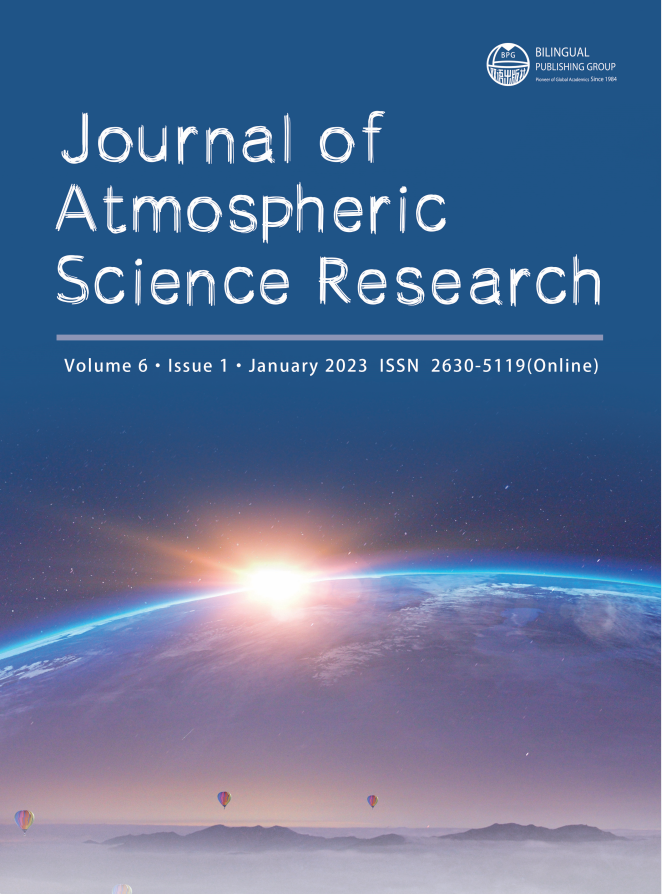-
853
-
417
-
378
-
364
-
363
Monitoring and Quantification of Carbon Dioxide Emissions and Impact of Sea Surface Temperature on Marine Ecosystems as Climate Change Indicators in the Niger Delta Using Geospatial Technology
DOI:
https://doi.org/10.30564/jasr.v6i1.5107Abstract
The Niger Delta marine environment has experienced a series of environmental disasters since the inception of oil and gas exploration, which can be attributed to climate change. Carbon dioxide (CO2) emissions and sea surface temperature (T) ties associated with burning fossil fuels, such as gas flaring, vehicular traffic, and marine vessel movement along the sea, are increasing. Using data extracted from the NASA Giovanni satellite’s Atmospheric Infrared Sounder (AIRS) and Moderate Resolution Imaging Spectroradiometer (MODIS), this study mapped the carbon footprint and T along the coastline into the deep sea from 2003 to 2011, using ArcGIS software. The spatial distribution of CO2 and T concentrations determined by the inverse distance weighting (IDW) method reveals variations in the study area. The results show an increase in the quantity of the mean tropospheric CO2 from July 2003 to December 2011, from 374.5129 ppm to 390.7831 ppm annual CO2 emissions, which also reflects a continuous increase. The average Monthly sea surface temperature had a general increasing trend from 25.79 °C in July 2003 to 27.8 °C in December, with the Pearson correlation coefficient between CO2 and T indicating 50% strongly positive, 20% strongly negative, 20% weakly positive,and 10% weakly negative. CO2 levels, like temperature, follow a seasonal cycle, with a decrease during the wet season due to precipitation dissolving and plant uptake during the growing season, and then a rise during the dry season. Carbon capture and storage technologies must be implemented to benefit the marine ecosystem and human well-being.Keywords:
Carbon footprint; NASA Giovanni; Climate change; Coastline; Carbon capture and storageReferences
[1] Melissa, D., Greenhouse Effect 101 [Internet]. [cited 2019 Jul 26]. Available from: https://www.nrdc.org/stories/greenhouse-effect-10
[2] United States Environmental Protection Agency [Internet]. [cited 2022 May 5]. Available from: https://www.epa.gov/ghgemissions/understand-ing-global-warming-potentials
[3] Alan, B., The Atmosphere: Getting a Handle on Carbon Dioxide [Internet]. [cited 2019 Oct 9]. Available from: https://climate.nasa.gov/news/2915/the-atmosphere-getting-a-han-dle-on-carbondioxide/#:~:text=Carbon%20dioxide%20is%20a%20different,between%20300%20to%201%2C000%20years
[4] Hansen, J.E., (Editor). Air Pollution as a Cli-mate Forcing; 2002 Apr 29-May 3; Hawaii. New York: NASA Goddard Institute for Space Studies.
[5] Petrokofsky, G., Kanamaru, H., Achard, F., 2012. Comparison of methods for measuring and assessing carbon stocks and carbon stock changes in terrestrial carbon pools. How do the accuracy and precision of current methods com-pare: A systematic review protocol. Environ-mental Evidence. 1, 6.
[6] Shakir, J.A., Mazin, Mashee, F., 2020. Monitor-ing and calculating the carbon dioxide emissions in Baghdad and its effect on increasing tem-peratures from 2003-2018 using remote sensing data. Periódico Tchê Qumica. 17, 357-371. DOI: https://doi.org/10.52571/PTQ.v17.n36.2020.372_Periodico36_pgs_357_371.pdf
[7] Prather, M., Ehhalt, D., In climate change 2001: The scientific basis: Contributions of working group I to the third assessment report of the In-tergovernmental panel on climate change, eds. Houghton, J.T., Ding, Y., Griggs, D.J., et al., Cambridge, U.K: Cambridge University Press; p. 239-287.
[8] NOAA National Centers for Environmental In-formation, Climate at a Glance [Internet]. 2019: Global Time Series [cited 2022 Aug 29]. Available from: https://www.ncei.noaa.gov/access/monitoring/climate-at-a-glance/
[9] Carbon Dioxide Capture and Storage : A Key Carbon Abatement Option (International Ener-gy Agency). China: OECD Publishing; 2008. p. 264. ISBN-10: 9264041400, ISBN-13: 978-9264041400
[10] National Ocean and Atmospheric Administra-tion [Internet]. Ocean Acidification [cited 2020 Apr 1]. Available from: https://www.noaa.gov/education/resource-collections/ocean-coasts/ocean-acidification
[11] Rajab, J.M., MatJafri, M.Z., Lim, H.S., et al., 2009. Satellite mapping of CO2 emissions from forest fires in Indonesia using AIRS measure-ments. Modern Applied Science. 3(12), 68-75.
[12] World Bank Group [Internet]. Current Climate Climatology 2021. Available from: https://cli-mateknowledgeportal.worldbank.org/country/Nigeria/climate-data-historical
[13] Anifowose, D., Lawler, D., Vander, H., et al., 2014. Evaluating interdiction of oil pipelines at river crossings using environmental impact assessments. Area. 46(1), 4-17. Available from: https://doi.org/10.1111/area.12065
[14] Burrough, P.A., McDonnell, R.A., Lloyd, C.D., Principles of geographical information systems. UK: Oxford University Press; 2015. p. 352.
[15] National Oceanic and Atmospheric Adminis-tration [Internet]. NOAA Merged Land Ocean Global Surface Temperature Analysis [Accessed March 2021]. Available from: https://www.ncei.noaa.gov/products/land-based-station/noaa-global-temp
[16] Ostrander, G.K., Armstrong, K.M., Knobbe, E.T., et al., 2000. Rapid transition in the struc-ture of a coral reef community: The effects of coral bleaching and physical disturbance. Pro-ceedings of the National Academy of Sciences. 97(10), 5297-5302.
[17] Pratchett, M.S., Wilson, S.K., Berumen, M.L., et al., 2004. Sublethal effects of coral bleaching on an obligate coral feeding butterflyfish. Coral Reefs. 23(3), 352-356.
[18] Pershing, A., Griffis, R., Jewett, E.B., et al., 2018. Oceans and marine resources: Impacts, risks, and adaptation in the United States. Vol-ume 2 : The Fourth National Climate Assess-ment. Available from: https://nca2018.global-change.gov/
[19] Robert, J., Nicholls, 2007. “Coastal Systems and Low-Lying Areas” in M. L. Parry et al., eds., Climate Change 2007: Impacts, Adaptation, and Vulnerability. Contribution of Working Group II to the Fourth Assessment Report of the Intergovern-mental Panel on Climate Change. Cambridge: Cambridge University Press; 2007. p. 327.
[20] Uyigue, E., Agho, M., 2007. Coping with Cli-mate Change and Environmental Degradation in the Niger Delta of Southern Nigeria, Community Research and Development Centre (CREDC) Nigeria [Internet]. Climate Change in Niger Del-ta-Global Greenhouse Warming. Available from: https://www.global-greenhouse-warming.com
[21] Chen, Y., Ye, Y., 2014. Effects of salinity and nutrient addition on mangrove excoecaria agallocha. Plos One. 9(4), e93337.
[22] FitzGerald, M., Fenster, M.S., Argow, B.A., et al., 2008. Coastal impacts due to sea-level rise. Annual Review of Earth and Planetary Sciences. 36, 601-47.
[23] Breitburg, Denise, L., Lisa, O., et al., 2018. Declin-ing oxygen in the global ocean and coastal waters. Science (New York, N.Y.). 359(10), 1126.
[24] Jones, B.A., Fleck, J., 2020. Shrinking lakes, air pollution, and human health: Evidence from California’s Salton Sea. Science of the Total En-vironment. 712, 136490.
Downloads
How to Cite
Issue
Article Type
License
Copyright © 2022 Authors

This is an open access article under the Creative Commons Attribution-NonCommercial 4.0 International (CC BY-NC 4.0) License.




 Okechukwu Okpobiri
Okechukwu Okpobiri






